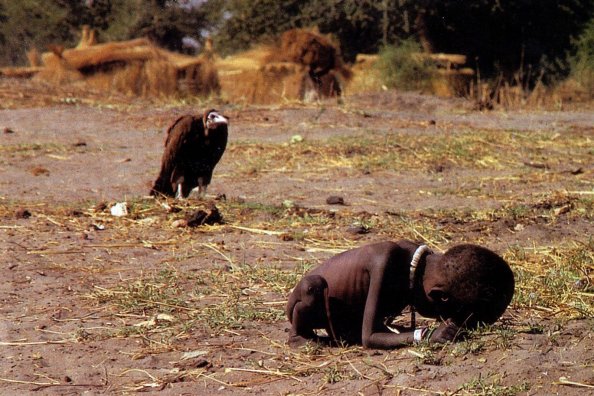Ethics – “Moral principles that govern a persons or groups behavior / the moral correctness of specified conduct” a definition taken from the online dictionary
It is best understood as moral decision, as conscience. To decide what is right or wrong within a situation that is taking place at the time it occurs. For example, if a war photographer is in a situation which could endanger a person’s life and he/she has the ability to save them in place of continuing their work, it is ethically correct to save the person’s life. In advertisement ethics is ruled by the (ASA) Advertising Standards Authority however ethics have been widely disregarded throughout photographic manipulation.
To highlight and example ethics I refer to photographer Kevin Carter. Carter photographed the poverty and poor living conditions in Sudan in 1993 March. He saw a young, small, skin and bones girl struggling to make it to the feeding center and she rested close by a vulture. Carter waited 20 minutes for the vulture to come dangerously close by before taking his photograph and scaring the vulture off. Afterwards he left the small girl there alone on the ground.
– Kevin Carter, ‘Struggling Girl’, Sudan 1993
By publishing the photo in the New York times he established awareness within the public but the public wrought outrage in heaps and bounds towards the fact he left the girl alone there without aiding her survival. You could say ethically he was both right and wrong, he created public awareness which is the main goal of any photo-journalist but in his cause, his own in-humanity and compassion was morally incorrect. This demonstrates how a photographer can change the photograph by the ethical decisions that are made.
So with this I can already see that the approach considered by the photographer into documentary photography is influenced by how the define and interpret it, the ethics and moral decisions they make and the contextual information they include to communicate to the audience.
What do you think?

March 3rd, 2015 → 3:48 pm
[…] Cogtography […]
March 20th, 2015 → 11:31 am
[…] reiterates it. 19. Starvation isn't Racist, Humans are. Source: Cogtography Not enough words for this one. 20. Barack Obama checking out a […]